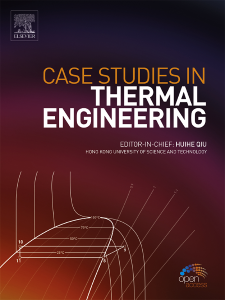Performance investigation on PVT collector with cerium oxide nano fluids
IF 6.4
2区 工程技术
Q1 THERMODYNAMICS
引用次数: 0
Abstract
The constant temperature rise on the solar panel surface causes a deterioration of electrical power generation. This article is provided with the performance of photovoltaic thermal (PVT) collector through cerium oxide with water as a base fluid. A small percentage of incoming radiation is transformed into electricity and rest of them is wasted as hot energy, the panel surface temperature will confine the performance of PV module. The research's objectives were to develop and construct a photovoltaic/thermal collector and evaluate its thermal and electrical energy as an output. The experimental investigation of PVT collector with two different concentration of cerium oxide 0.5 and 1.0 LPM (litres per minute). As per the investigations on the PVT collector results were obtained as electrical performance of collector was attained about 18.56 %, 19.12 % for the flow rate of 0.5 and 1.0 LPM. Similarly, thermal performance was achieved 48.38 %, 54.03 % for the flow rate of 0.5 and 1.0 LPM. Thermal conductivity of cerium oxide nano fluid was much better than the air and water. It was observed that employing a nano fluid to the receiver might increase the efficiency around 5–10 %, compared to utilising water as a base fluid, water can only generate 3–7 %. As a cooling medium, air has a relatively low production capacity between 2 and 3 %.
使用纳米氧化铈流体的 PVT 集热器性能研究
太阳能电池板表面持续升温会导致发电性能下降。本文介绍了以水为基液的氧化铈光电热(PVT)集热器的性能。入射辐射中只有一小部分转化为电能,其余都以热能的形式被浪费掉,因此太阳能电池板表面的温度会限制光伏组件的性能。该研究的目标是开发和建造光伏/热能收集器,并评估其输出的热能和电能。对使用两种不同浓度的氧化铈(0.5 升/分钟和 1.0 升/分钟)的光伏集热器进行了实验研究。根据对 PVT 集热器的研究结果,在流量为 0.5 和 1.0 LPM 时,集热器的电性能分别达到约 18.56 % 和 19.12 %。同样,流量为 0.5 和 1.0 LPM 时,热性能分别达到 48.38 % 和 54.03 %。氧化铈纳米流体的导热性能远远优于空气和水。据观察,与使用水作为基础流体(水只能产生 3-7% 的热量)相比,在接收器中使用纳米流体可提高约 5-10% 的效率。作为冷却介质,空气的生产能力相对较低,仅为 2% 至 3%。
本文章由计算机程序翻译,如有差异,请以英文原文为准。
求助全文
约1分钟内获得全文
求助全文
来源期刊

Case Studies in Thermal Engineering
Chemical Engineering-Fluid Flow and Transfer Processes
CiteScore
8.60
自引率
11.80%
发文量
812
审稿时长
76 days
期刊介绍:
Case Studies in Thermal Engineering provides a forum for the rapid publication of short, structured Case Studies in Thermal Engineering and related Short Communications. It provides an essential compendium of case studies for researchers and practitioners in the field of thermal engineering and others who are interested in aspects of thermal engineering cases that could affect other engineering processes. The journal not only publishes new and novel case studies, but also provides a forum for the publication of high quality descriptions of classic thermal engineering problems. The scope of the journal includes case studies of thermal engineering problems in components, devices and systems using existing experimental and numerical techniques in the areas of mechanical, aerospace, chemical, medical, thermal management for electronics, heat exchangers, regeneration, solar thermal energy, thermal storage, building energy conservation, and power generation. Case studies of thermal problems in other areas will also be considered.
 求助内容:
求助内容: 应助结果提醒方式:
应助结果提醒方式:


